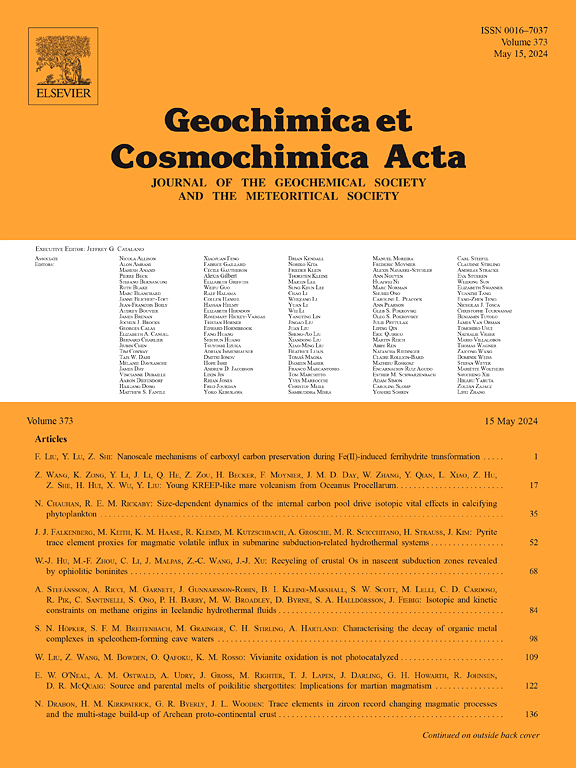北极多年冻土区预老化有机碳来源和循环的生物标志物14C证据
IF 5
1区 地球科学
Q1 GEOCHEMISTRY & GEOPHYSICS
引用次数: 0
摘要
永久冻土解冻有可能释放出储存了数千年的古老颗粒和溶解有机物。以前的研究表明,永久冻土中的溶解有机物非常不稳定,可以被靠近解冻区的异养微生物利用。然而,古代颗粒有机物是否也能被利用尚不清楚。本研究旨在调查北极微生物群落(细菌和古生菌)是否将永久冻土融化可能释放的古老有机物纳入其生物量。我们比较和对比了来自加拿大北极麦肯齐河流域的5个土壤剖面和7个三角洲湖泊沉积物岩心的微生物脂质和高等植物生物标志物(代表陆相有机质)的放射性碳特征。在表层土壤中,现代到后现代短链脂肪酸(SCFA)年龄表明了原位微生物生产,有机碳(OC)循环的不同速率取决于土壤湿度。相比之下,深层土壤中的SCFA显示了千年的年龄,这可能代表了通过矿物结合保存的微生物坏死团。在与河流分离的三角洲湖泊中,通常年老的SCFA表明细菌吸收了未老化的OC。在常年连通的湖泊中,预老化的短链脂肪酸可能来源于微生物对老OC的原位吸收或来自麦肯齐河。较高的植物源长链脂肪酸(LCFA)表现出较老的放射性碳年龄,反映了土壤(高闭合性湖泊)或河流运输(非闭合性湖泊和低闭合性湖泊)在预老化过程中的矿物稳定。古菌脂质在高封闭性湖泊中比SCFA和LCFA年轻,在低封闭性湖泊和无封闭性湖泊中比LCFA更老,这反映了由于它们的异养生产而产生的大量放射性碳特征。因此,这些细菌生物标记脂质的放射性碳特征可能反映了古代OC的微生物结合(例如,来自永久冻土解冻)或特殊保存(例如,通过矿物稳定)。因此,即使在相对较高的OC环境中,如北极水生生态系统,微生物也可以依靠古OC来生长。本文章由计算机程序翻译,如有差异,请以英文原文为准。
Biomarker 14C evidence for sources and recycling of pre-aged organic carbon in Arctic permafrost regions
Permafrost thaw has the potential to release ancient particulate and dissolved organic matter that had been stored for thousands of years. Previous studies have shown that dissolved organic matter from permafrost is very labile and can be used by heterotrophic microbes close to the thaw area. However, it is unknown if ancient particulate organic matter can also be utilized. This study aims to investigate whether arctic microbial communities (bacteria and Archaea) incorporate ancient organic matter potentially released from thawing permafrost into their biomass. We compare and contrast the radiocarbon signatures of microbial lipids and higher plant biomarkers (representing terrestrial organic matter) from five soil profiles and seven deltaic lake sediment cores from the Mackenzie River drainage basin, Arctic Canada. In the surface soils, modern to post-modern short-chain fatty acids (SCFA) ages indicate in situ microbial production, with differential rates of organic carbon (OC) cycling depending on soil moisture. In contrast, SCFA in deeper soils display millennial ages, which likely represent the microbial necromass preserved through mineral association. In deltaic lakes that are disconnected from the river, generally old SCFA suggests the uptake of pre-aged OC by bacteria. In perennially connected lakes, pre-aged SCFA could originate from in situ microbial uptake of old OC or from the Mackenzie River. Higher plant-derived long-chain fatty acids (LCFA) present older radiocarbon ages, reflecting mineral stabilization during either pre-aging in soils (for high closure lakes) or riverine transport (for no and low closure lakes). Archaeal lipids are younger than SCFA and LCFA in high closure lakes, and older in low and no closure lakes, mirroring bulk radiocarbon signatures due to their heterotrophic production. These radiocarbon signatures of bacterial biomarker lipids may therefore reflect microbial incorporation of ancient OC (e.g., derived from permafrost thaw) or exceptional preservation (e.g., through mineral stabilization). Hence, even in relatively high OC environments such as arctic aquatic ecosystems, microbes can rely on ancient OC for their growth.
求助全文
通过发布文献求助,成功后即可免费获取论文全文。
去求助
来源期刊

Geochimica et Cosmochimica Acta
地学-地球化学与地球物理
CiteScore
9.60
自引率
14.00%
发文量
437
审稿时长
6 months
期刊介绍:
Geochimica et Cosmochimica Acta publishes research papers in a wide range of subjects in terrestrial geochemistry, meteoritics, and planetary geochemistry. The scope of the journal includes:
1). Physical chemistry of gases, aqueous solutions, glasses, and crystalline solids
2). Igneous and metamorphic petrology
3). Chemical processes in the atmosphere, hydrosphere, biosphere, and lithosphere of the Earth
4). Organic geochemistry
5). Isotope geochemistry
6). Meteoritics and meteorite impacts
7). Lunar science; and
8). Planetary geochemistry.
 求助内容:
求助内容: 应助结果提醒方式:
应助结果提醒方式:


